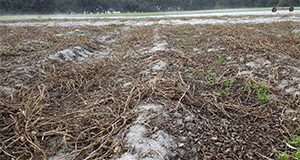Effective irrigation scheduling enables the irrigator to apply the right amount of water at the right time to meet the crop water demand. This 19-page guide presents information on average daily and weekly crop water use and crop growth stages for twelve north Florida crops that can be used to help schedule irrigation. This will allow a grower to develop a realistic irrigation schedule that minimizes plant water stress, saves water, and reduces nutrient leaching potential. Written by Vivek Sharma, Charles Barrett, De Broughton, and Thomas Obreza, and published by the UF/IFAS Department of Soil and Water Sciences, revised December 2020.
https://edis.ifas.ufl.edu/ss491
Tag: crops
Nitrogen Contributions from Peanut Residues to Subsequent Crops
There is not enough evidence to support current peanut N credit recommendations in the Southeast. Nitrogen is released rapidly from peanut residues, and it moves quickly through light-textured soils found in this region. Only a relatively small amount of N from peanut residues is available when subsequent crops need it. This new 5-page document discusses peanut nitrogen credits, nitrogen release from peanut residues, crop performance following peanut, tillage and nitrogen release, and peanut residue distribution and nitrogen release. Written by Arun Jani and Michael J. Mulvaney, and published by the UF/IFAS Agronomy Department, April 2019.
http://edis.ifas.ufl.edu/ag431

